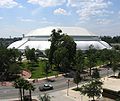This article may be in need of reorganization to comply with Wikipedia's layout guidelines .(February 2023) |
| Company type | Private company |
|---|---|
| Industry | Structural Engineering |
| Founded | 1988 |
| Headquarters | |
Key people | David M. Campbell, P.E. (Principal, CEO Emeritus) Paul A. Gossen, P.E., F.ASCE (Principal Emeritus) Stephen P. Emery, P.E. (Principal) Timothy D. Mills (Principal ) Karen A. Lynch, P.E. (Principal, President) Eric E. Dahl, P.E. (Principal) Dorota Rogulska (Principal) |
| Services | Consulting Tensile Membrane Structures Long Span Structures Sports Facilities Retractable Roofs Entertainment Engineering |
| Website | www |
Geiger Engineers is the doing business name of Geiger Lynch Emery Campbell Engineers, P.C., an American structural engineering consulting firm located northwest of New York City. Founded in 1988 by David H. Geiger, Paul A. Gossen, Kris P. Hamilton, David D. Chen, David M. Campbell, and Mike Liao, [1] the company has worked on large projects throughout the world. Starting from long span and tensile membrane structures, Geiger Engineers has branched out over the years into a range of specialties from designing sports facilities to providing engineering services for the entertainment industry.
Contents
- History
- Notable projects
- Sports facilities and convention centers
- Renovations and expansions
- Entertainment and recreation projects
- Tensile Membrane
- Domes (primarily as Geiger Berger Associates)
- Center Hung Scoreboards and LED Structures
- Gallery
- Notes
Recent high-profile projects include the new roof on the JMA Dome (formerly the Carrier Dome) at Syracuse University, [2] winner of NCSEA's 2021 Excellence in Structural Engineering Award for Forensic/Renovation/Retrofit/Rehabilitation Structures over $20 Million; [3] the Credit One Stadium renovations, new Stage House and canopy; [1] the USTA's Louis Armstrong Stadium which was a finalist in the SEAoNY 2020 Excellence in Structural Engineering (EiSE) Awards; [4] and Ariens Hill at Titletown, winner of the ASLA 2019 Wisconsin Award and the AIA 2018 Michigan Building Award, among others. [5]
In addition to providing a wide range of engineering services, Geiger Engineers remains involved in industry innovations. For example, Tensotherm (trademark) - a composite fabric insulated with Lumira aerogel - was developed by Cabot Corporation, Birdair, and Geiger Engineers. [6] In 2008 it was used for the first time on the Dedmon Athletic Center’s new roof. [7]
More recently, Geiger developed a nonlinear bearing for large moveable structures such as retractable roofs. This now patented nonlinear bearing [8] is an improvement on the commonly used linear bearing in that it can combine rotation and translation in varying ways, giving structural designers greater flexibility.



























